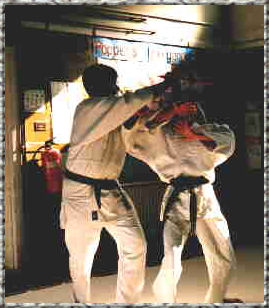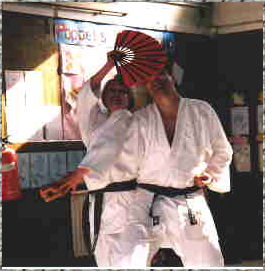I first started Aikido as a means of wanting to learn a way of defending
myself should the need
arise. I  wanted the confidence in myself to know that I could protect myself
if faced with a situation of any kind. After watching an Aikido class for
the first time I remember driving home thinking that what I had just seen
wasn't for me, I wanted an effective self defence class and what I had just
witnessed seemed to be more of a choreographed dance routine. Something though
drew me back to the next training session, this time I wanted to take part
not knowing what to expect from this `art' I attended with an open mind ready
to receive instruction. On my second visit to the training hall, dojo, I felt
as I entered a sense of quiet formality surrounding the dojo. People were
already on the mat, the tatami, they were fitted out in crisp white gi's some
were wearing hakama's and as I stood awkwardly by the side of the mat I noticed
how people on the mat seemed to glide along the mat as if floating on air.
There seemed to be no conflict everyone seemed as if they were one. As I stood
there my mind took me back to the first lesson I had watched I remember watching
the class `attack' one another and as the, attacker, uke, launched into his
attack the person receiving the attack, tori , would move slightly forward
to meet uke. What seemed strange was the fact that uke seemed to surrender
his attack and allow tori to take control. I couldn't grasp this concept at
first, why would an attacker only go so far and then give up and allow the
intended victim the chance to apply a technique or to immobilise.
wanted the confidence in myself to know that I could protect myself
if faced with a situation of any kind. After watching an Aikido class for
the first time I remember driving home thinking that what I had just seen
wasn't for me, I wanted an effective self defence class and what I had just
witnessed seemed to be more of a choreographed dance routine. Something though
drew me back to the next training session, this time I wanted to take part
not knowing what to expect from this `art' I attended with an open mind ready
to receive instruction. On my second visit to the training hall, dojo, I felt
as I entered a sense of quiet formality surrounding the dojo. People were
already on the mat, the tatami, they were fitted out in crisp white gi's some
were wearing hakama's and as I stood awkwardly by the side of the mat I noticed
how people on the mat seemed to glide along the mat as if floating on air.
There seemed to be no conflict everyone seemed as if they were one. As I stood
there my mind took me back to the first lesson I had watched I remember watching
the class `attack' one another and as the, attacker, uke, launched into his
attack the person receiving the attack, tori , would move slightly forward
to meet uke. What seemed strange was the fact that uke seemed to surrender
his attack and allow tori to take control. I couldn't grasp this concept at
first, why would an attacker only go so far and then give up and allow the
intended victim the chance to apply a technique or to immobilise.
Soon the class began and I now stood on the mat in a line facing kamiza I remember looking down the line and thinking how proud these other students seemed, they stood in this line rigid but relaxed the air seemed to be fill with peace. After the opening ceremony we launched into warm up exercises these exercises seemed to concentrate on balance and breathing. I remember Sensei yelling throughout the lessons things about `breathing', `centring', `blending' and to use to use your hara. At the time I couldn't grasp why we were being told about these things but I kept going, as the lesson went on I was drawn more and more into this gentle way. I had been bitten by the bug, I yearned to find the magic behind this art. As weeks turned into months I was slowly realizing the effectiveness of this art, what started out as a quest to find a martial art which was capable of being an effective self defence slowly turned into a voyage of discovery about myself, my peers and all things that surround us.
 I have learnt
that centering is the foundation of Aikido practice. To be centered is to
say yes to life and to be positive, it forms the past and the present, heaven
and earth, the way in and the way out of life's problems. Your hara is a secure
place from where you venture out and a place you can always return to, a place
at the center of your universe that keeps you balanced and positive, a place
from which energy can be extended without the need for violence. From this
center comes the breath of life a daily function that keeps us alive. It was
not until I took up Aikido that I realized how much I took this simple function
for granted. Everyone breathes a thousand times a day but it is not until
you begin to understand why that you realize its true meaning. To be able
to control your breathing at all times in any situation is a way in which
conflict can be defeated before it begins. Think back to a situation where
you were put under pressure, it could be at work, family life or anything
else. This situation causes you to become tense and uptight you feel trapped
and can find no way out so you do the natural thing and fight, thus causing
conflict. These actions cause you to become un-centered, off balance and vulnerable.
If on the other hand you had adapted a more centered approach to the problem
at hand and concentrated on your balance and breathing the energy that you
would expel from your hara would engulf the problem, blend with it and end
the conflict without the need for conflict or violence.
I have learnt
that centering is the foundation of Aikido practice. To be centered is to
say yes to life and to be positive, it forms the past and the present, heaven
and earth, the way in and the way out of life's problems. Your hara is a secure
place from where you venture out and a place you can always return to, a place
at the center of your universe that keeps you balanced and positive, a place
from which energy can be extended without the need for violence. From this
center comes the breath of life a daily function that keeps us alive. It was
not until I took up Aikido that I realized how much I took this simple function
for granted. Everyone breathes a thousand times a day but it is not until
you begin to understand why that you realize its true meaning. To be able
to control your breathing at all times in any situation is a way in which
conflict can be defeated before it begins. Think back to a situation where
you were put under pressure, it could be at work, family life or anything
else. This situation causes you to become tense and uptight you feel trapped
and can find no way out so you do the natural thing and fight, thus causing
conflict. These actions cause you to become un-centered, off balance and vulnerable.
If on the other hand you had adapted a more centered approach to the problem
at hand and concentrated on your balance and breathing the energy that you
would expel from your hara would engulf the problem, blend with it and end
the conflict without the need for conflict or violence.
Blending isn't a trick, it involves true understanding of the other persons intentions and feelings. To blend is to move toward an attack creating a dance that joins attacker and defender and opens the way to reconciliation. When we blend with others we are not necessarily agreeing with the intentions of the attacker what we are doing is connecting with them and with the problems at hand only then can we see things from their point of view and can then offer solutions. In Aikido to see things from another's point of view we perform a movement called `tenkan' which means to turn. An Aikidoist generally moves toward the attack and slightly off the line of attack whilst at the same time making a turn manoeuvre that leaves him next to the attacker and facing in the same direction as the attacker. In this position the aikidoist is looking at the situation from the attackers viewpoint, from this position many possibilities exist that enable us to defeat conflict in a peaceful way. We are effectively protecting the attacker allowing lines of communication to expand and thus increasing the likelihood that a conflict can be resolved without the use of physical force. Another aspect of Aikido is randori, randori teaches us that when confronted by a crisis of any kind we should not latch onto the problem but we should offer solutions or pass the crisis on to the person best able to deal with it.
The simple yet profound teachings of Aikido can be successfully applied to whatever path we walk in life. The world we live in offers us many different paths in which to walk and lead us astray, but the path of Aikido remains true and is always there waiting for us.
Paul Khan Nidan